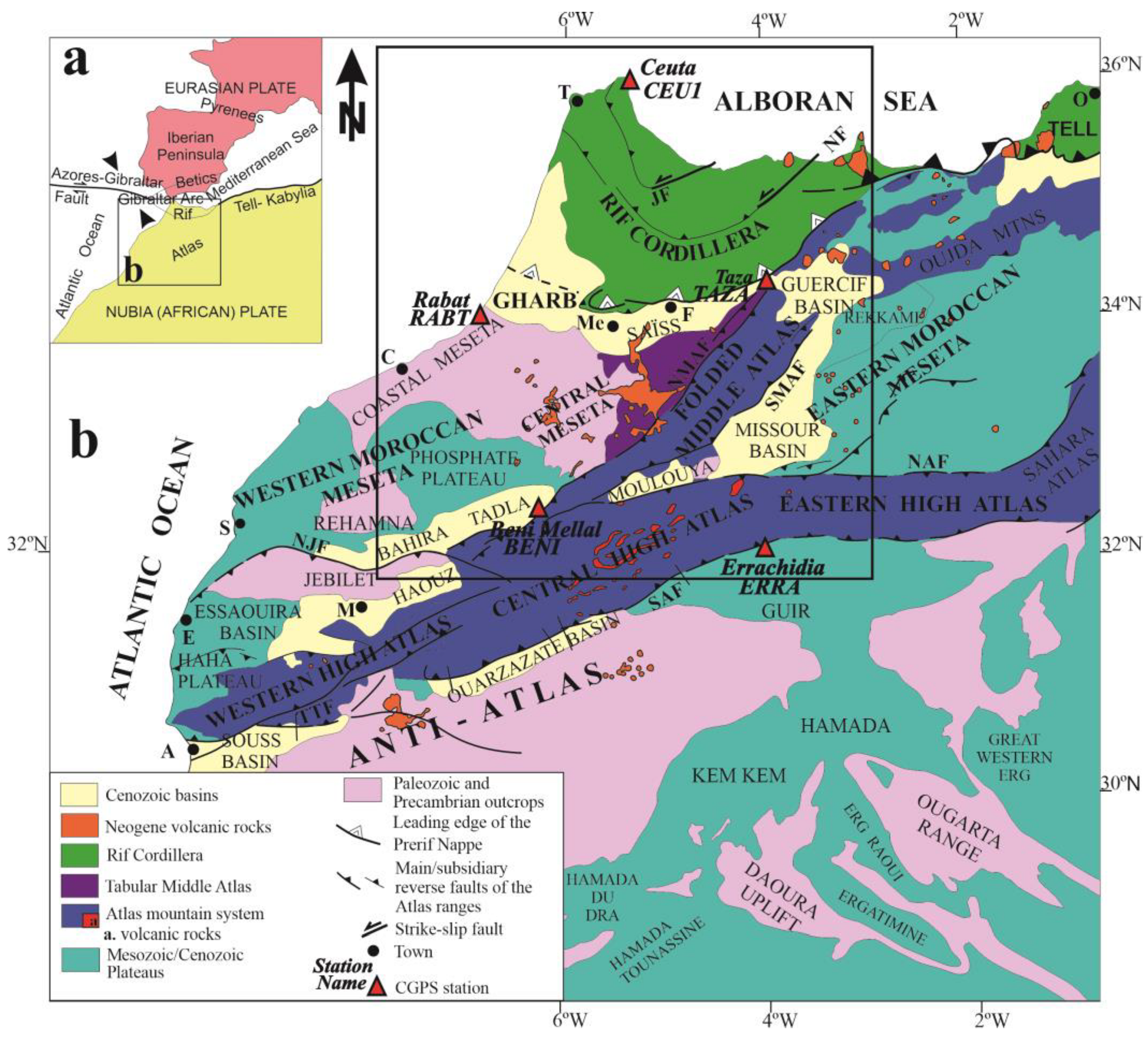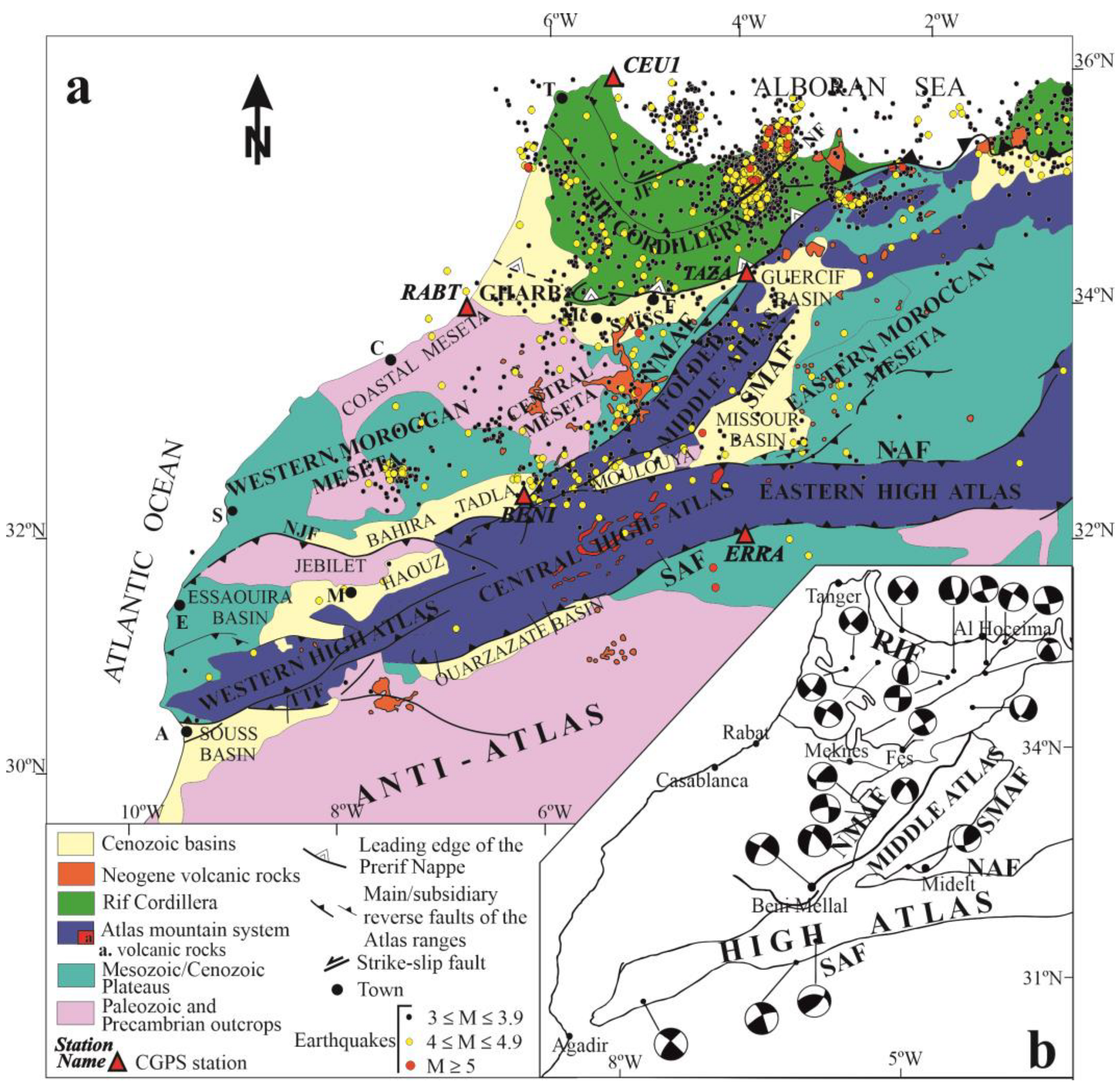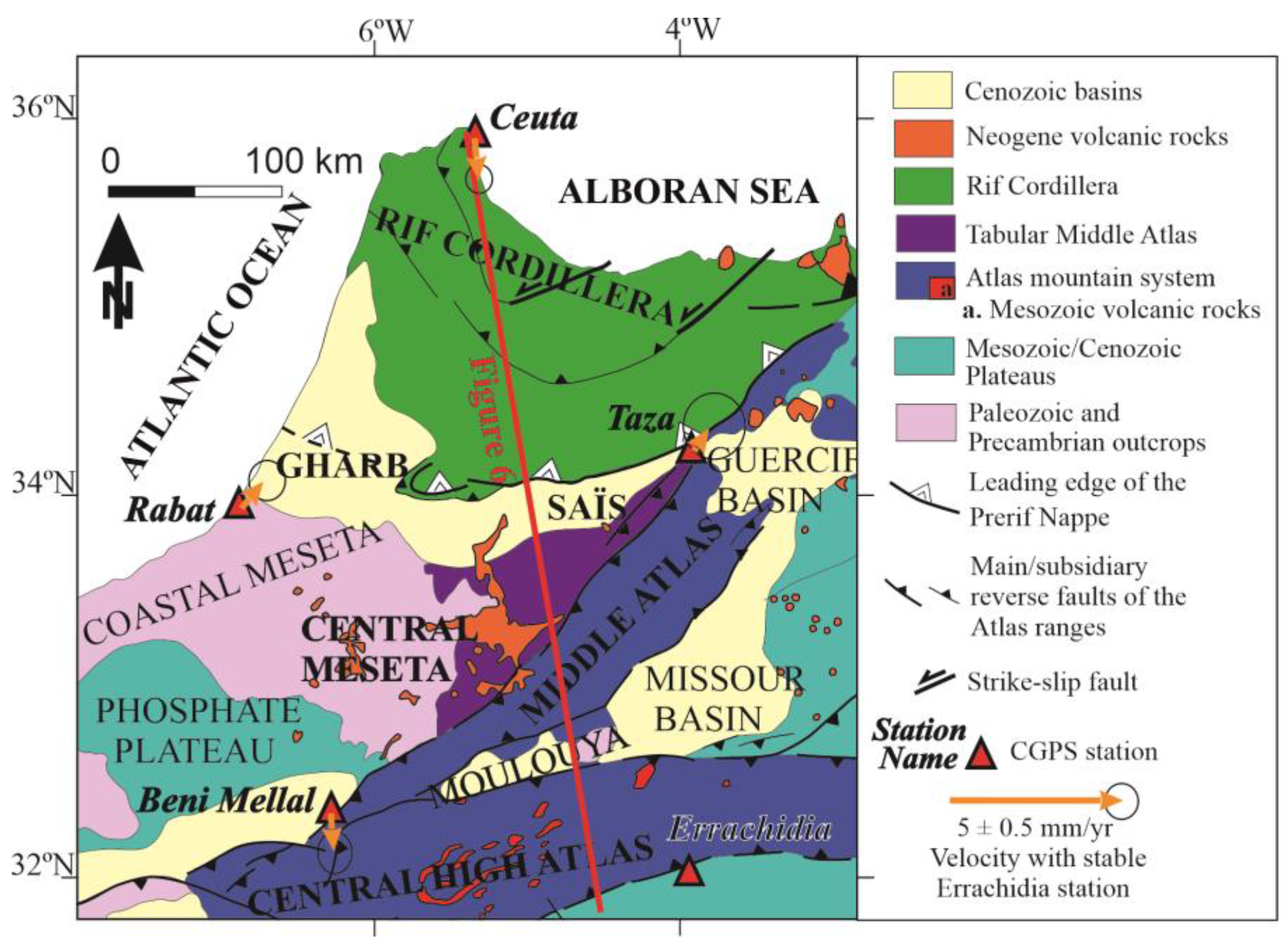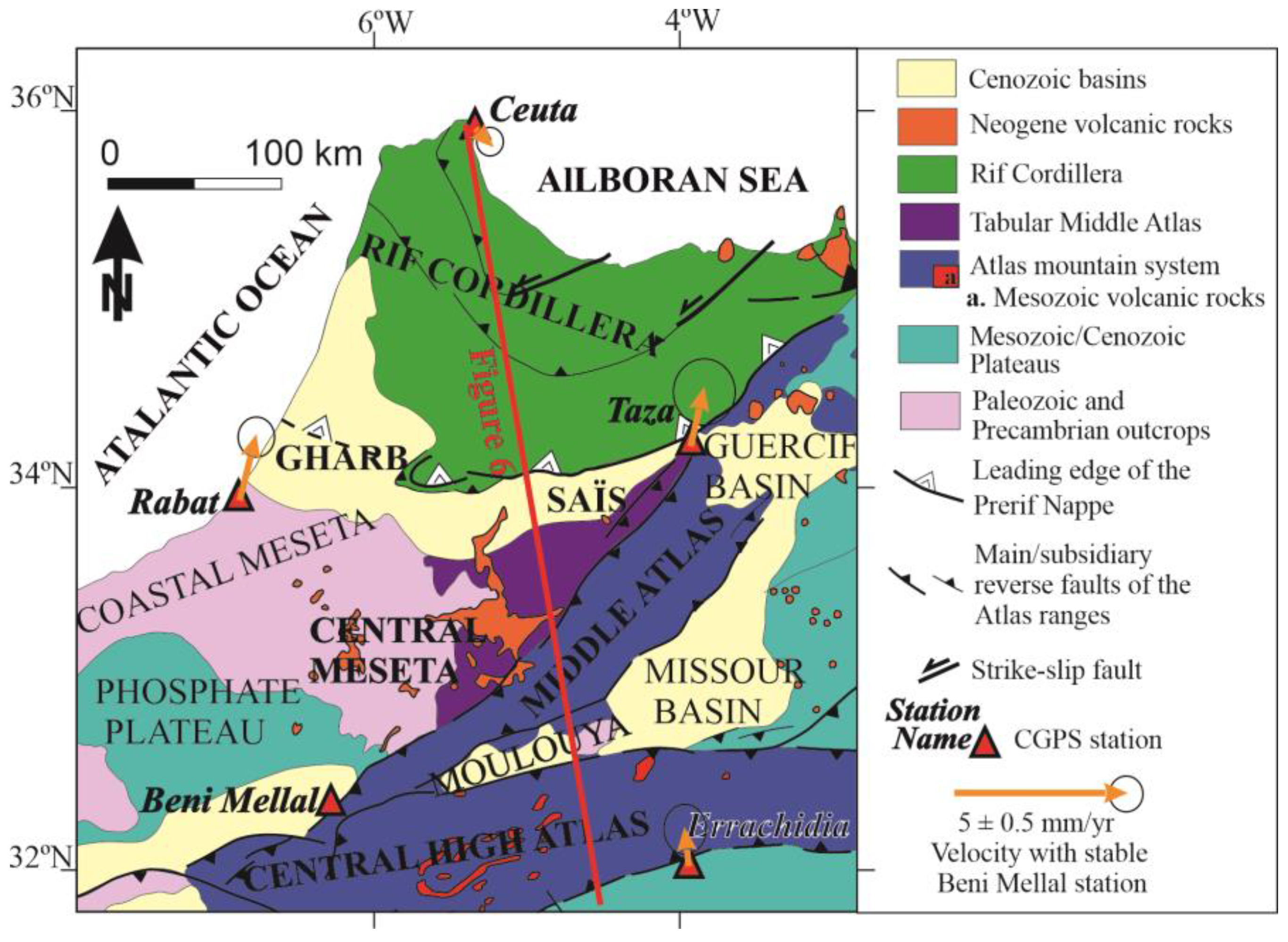cGPS Record of Active Extension in Moroccan Meseta and Shortening in Atlasic Chains under the Eurasia-Nubia Convergence
Abstract
1. Introduction
2. Geological Setting
2.1. Tectonic Structure
2.2. Seismological and Active Tectonic Setting
2.3. Geodynamic Models
3. cGPS Network, Equipment and Data Processing
- Errachidia (ERRA) is located over the Anti-Atlas basement and represents a reference for the stable Nubian plate. It is located just close to the active South Atlasic thrust front, where the central High Atlas overrides the Anti Atlas. This station is located on the Mesozoic-Cenozoic plateaus developed on the Precambrian-to-Paleozoic basement. No recent geological deformation occurs southward of this station.
- Béni Mellal (BENI) is located in the Tadla basin, a foredeep Atlasic structure floored by the southernmost boundary of the western Meseta basement. The station is located close to the active Northern Atlasic Fault thrust front and also close to the North Middle Atlas Fault.
- Rabat (RABT) is located in the northernmost outcrops of the Western Moroccan Meseta, in a region of scarce seismicity close to the southern margin of the Gharb basin, an Alpine Rifian foreland basin.
- Taza (TAZA) is a key station located on the easternmost outcrops of the central Meseta, close to the North Middle Atlas Fault and close to the junction with the collisional front of the central southern Rif along the boundary with the Middle-Atlasic basement.
- Ceuta (CEU1) is located at the northernmost end of the Alpine Rif chain, i.e., in the central part of the Nubia-Eurasia interplate area, and contributes to determining the present-day displacements of the Gibraltar Arc.

4. Velocity Rates from cGPS Stations
5. Discussion
5.1. Analysis of the cGPS Tectonic Displacements
5.2. Strain Partitioning in the Northern Nubian Plate Boundary: Towards an Integrated Tectonic Model
6. Conclusions
Author Contributions
Funding
Institutional Review Board Statement
Informed Consent Statement
Data Availability Statement
Conflicts of Interest
References
- Allmendinger, R.W.; Loveless, J.P.; Pritchard, M.E.; Meade, B. From decades to epochs: Spanning the gap between geodesy and structural geology of active mountain belts. J. Struct. Geol. 2009, 31, 1409–1422. [Google Scholar] [CrossRef]
- Laville, E.; Piqué, A. La distension crustale atlantique et atlasique au Maroc au début du Mésozoïque: Le rejeu des structures hercyniennes. Bull. Soc. Geol. Fr. 1991, 162, 1161–1171. [Google Scholar]
- Anahnah, F.; Galindo-Zaldívar, J.; Chalouan, A.; Pedrera, A.; Ruano, P.; Pous, J.; Heise, W.; Ruiz-Constán, A.; Benmakhlouf, M.; López-Garrido, A.C.; et al. Deep resistivity cross section of the intraplate Atlas Mountains (NW Africa): New evidence of anomalous mantle and related Quaternary volcanism. Tectonics 2011, 30, TC5014. [Google Scholar] [CrossRef]
- De Mets, C.; Gordon, R.; Argus, D.; Stein, S. Effect of recent revisions to thegeomagnetic reversal time scale on estimates of current plate motions. Geophys. Res. Lett. 1994, 21, 2191–2194. [Google Scholar] [CrossRef]
- Nocquet, J.M. Present-day kinematics of the Mediterranean: A comprehensive overview of GPS results. Tectonophysics 2012, 579, 220–242. [Google Scholar] [CrossRef]
- Fadil, A.; Vernant, P.; Mcclusky, S.; Reilinger, R.; Gomez, F.; Ben Sari, D.; Mourabit, T.; Feigl, K.L.; Barazangi, M. Active tectonics of the western Mediterranean: Geodetic evidence for rollback of a delaminated subcontinental lithospheric slab beneath the Rif Mountains, Morocco. Geology 2006, 34, 529–532. [Google Scholar] [CrossRef]
- Vernant, P.; Fadil, A.; Mourabit, T.; Ouazar, D.; Koulali, A.; Davila, J.M.; Gárate, J.; McClusky, S.; Reilinger, R. Geodetic constraints on active tectonics of the Western Mediterranean: Implications for the kinematics and dynamics of the Nubia-Eurasia plate boundary zone. J. Geodyn. 2010, 49, 123–129. [Google Scholar] [CrossRef]
- Koulali, A.; Ouazara, D.; Tahayt, A.W.; King, R.; Vernant, P.; Reilinger, R.E.; McClusky, S.; Mourabit, T.; Davila, J.M.; Amraoui, N. New GPS constraints on active deformation along the Africa–Iberia plate boundary. Earth Planet. Sci. Lett. 2011, 308, 211–217. [Google Scholar] [CrossRef]
- Chalouan, A.; Gil, A.J.; Galindo-Zaldívar, J.; Ahmamou, M.F.; Ruano, P.; de Lacy, M.C.; Ruiz-Armenteros, A.M.; Benmakhlouf, M.; Riguzzi, F. Active faulting in the frontal Rif Cordillera (Fes region, Morocco): Constraints from GPS data. J. Geodyn. 2014, 77, 110–122. [Google Scholar] [CrossRef]
- Palano, M.; González, P.J.; Fernández, J. The Diffuse Plate boundary of Nubia and Iberia in the Western Mediterranean: Crustal deformation evidence for viscous coupling and fragmented lithosphere. Earth Planet. Sci. Lett. 2015, 430, 439–447. [Google Scholar] [CrossRef]
- Gárate, J.; Martin-Davila, J.; Khazaradze, G.; Echeverria, A.; Asensio, E.; Gil, A.J.; de Lacy, M.C.; Armenteros, J.A.; Ruiz, A.M.; Gallastegui, J.; et al. Topo-Iberia project: CGPS crustal velocity field in the Iberian Peninsula and Morocco. GPS Solut. 2014, 19, 287–295. [Google Scholar] [CrossRef]
- González-Castillo, L.; Galindo-Zaldívar, J.; de Lacy, M.C.; Borque, M.J.; Martínez-Moreno, F.J.; García-Armenteros, J.A.; Gil, A.J. Active rollback in the Gibraltar Arc: Evidences from CGPS data in the western Betic Cordillera. Tectonophysics 2015, 663, 310–321. [Google Scholar] [CrossRef]
- Bargach, K.; Ruano, P.; Chabli, A.; Galindo-Zaldívar, J.; Chalouan, A.; Jabaloy, A.; Akil, M.; Ahmamou, M.; San De Galdiano, C.; Benmakhlouf, M. Recent tectonic deformations and stresses in the frontal part of the Rif Cordillera and the Saïss Basin (Fes and Rabat regions, Morocco). Pure Appl. Geophys. 2004, 161, 521–540. [Google Scholar] [CrossRef]
- Michard, A.; Frizon de Lamotte, D.; Saddiqi, O.; Chalouan, A. An outline of the geology of Morocco. In Continental Evolution: The Geology of Morocco: Structure, Stratigraphy, and Tectonics of the Africa-Atlantic-Mediterranean Triple Junction; Michard, A., Saddiqi, O., Chalouan, A., Frizon de Lamotte, D., Eds.; Springer: Berlin/Heidelberg, Germany, 2008; pp. 1–31. [Google Scholar]
- Ramdani, F. Geodynamic implications of intermediate-depth earthquakes and volcanism in the intraplate Atlas mountains (Morocco). Phys. Earth Planet. Inter. 1998, 108, 245–260. [Google Scholar] [CrossRef]
- Mora, A.; Parra, M.; Strecker, M.R.; Kammer, A.; Dimaté, C.; Rodríguez, F. Cenozoic contractional reactivation of Mesozoic extensional structures in the Eastern Cordillera of Colombia. Tectonics 2006, 25. [Google Scholar] [CrossRef]
- El Azzouzi, M.H.; Maury, R.C.; Bellon, H.; Youbi, N.; Cotten, J.; Kharbouch, F. Petrology and K-Ar chronology of the Neogene-quaternary Middle Atlas basaltic province, Morocco. Bull. Soc. Geol. Fr. 2010, 181, 243–257. [Google Scholar] [CrossRef]
- Harris, R.A. Large earthquakes and creeping faults. Rev. Geophys. 2017, 55, 169–198. [Google Scholar] [CrossRef]
- Galindo-Zaldívar, J.; Chalouan, A.; Azzouz, O.; Sanz de Galdeano, C.; Anahnah, F.; Ameza, L.; Ruano, P.; Pedrera, A.; Ruiz-Constán, A.; Marín-Lechado, C.; et al. Are the seismological and geological observations of the Al Hoceima (Morocco, Rif) 2004 earthquake (M = 6.3) contradictory? Tectonophysics 2009, 475, 59–67. [Google Scholar] [CrossRef]
- Roldán, F.J.; Galindo-Zaldívar, J.; Ruano, P.; Chalouan, A.; Pedrera, A.; Ahmamou, M.; Ruiz-Constán, A.; Sanz de Galdeano, C.; Benmakhlouf, M.; López-Garrido, A.C.; et al. Basin evolution associated to curved thrusts: The Prerif Ridges in the Volubilis area (Rif Cordillera, Morocco). J. Geodyn. 2014, 77, 56–69. [Google Scholar] [CrossRef]
- Ahmamou, M.; Chalouan, A. Distension synsédimentaire plio-quaternaire et rotation anti-horaire des contraintes au Quaternaire ancien sur la bordure nord du bassin du Saïss (Maroc). Bull. De L’institut Sci. 1988, 12, 19–26. [Google Scholar]
- Chalouan, A.; Galindo-Zaldivar, J.; Akil, M.; Marin, C.; Chabli, A.; Ruano, P.; Bargach, K.; Sanz de Galdeano, C.; Benmakhlouf, M.; Ahmamou, M.; et al. Tectonic wedge escape in the southwestern front of the Rif Cordillera (Morocco). In Tectonics of the Western Mediterranean and North Africa; Moratti, G., Chalouan, A., Eds.; Geological Society Publishing House: Bath, UK, 2006; pp. 101–118. [Google Scholar]
- Hinaje, S. Tectonique Cassante et Paléochamps de Contraintes Dans le Moyen Atlas et le Haut Atlas Central (Midelt-Errachidia) Depuis le Trias Jusqu’à l’Actuel. Ph.D. Thesis, Université Mohammed V, Rabat, Morocco, 2004. [Google Scholar]
- Chabli, A. Études Sedimentologique et Neotectonique des Formations Plio-Quaternaire Littorales Entre Rabat et Casablanca. Ph.D. Thesis, Université de Mohammed V, Rabat, Morocco, 2009. [Google Scholar]
- Chabli, A.; Chalouan, A.; Akil, M.; Galindo-Zaldívar, J.; Ruano, P.; Sanz De Galdeano, C.; López-Garrido, A.C.; Marin-Lechado, C.; Pedrera, A. Plio-Quaternary paleostresses in the Atlantic passive margin of the Moroccan Meseta: Influence of the Central Rif escape tectonics related to Eurasian-African plate convergence. J. Geodyn. 2014, 77, 123–134. [Google Scholar] [CrossRef]
- Gutscher, M.A.; Malod, J.; Rehault, J.P.; Contrucci, I.; Klingelhöfer, F.; Spakman, W.; Sismar Scientific Team. Active subduction beneath the Gibraltar Arc. In Proceedings of the EGS General Assembly Conference Abstracts, Vienna, Austria, 23–27 May 2002. [Google Scholar]
- Gutscher, M.A.; Dominguez, S.; Westbrook, G.K.; Le Roy, P.; Rosas, F.; Duarte, J.C.; Terrinha, P.; Miranda, J.M.; Graindorge, D.; Gailler, A.; et al. The Gibraltar subduction: A decade of new geophysical data. Tectonophysics 2012, 574, 72–91. [Google Scholar] [CrossRef]
- Pedrera, A.; Ruiz-Constan, A.; Galindo-Zaldívar, J.; Chalouan, A.; Sanz de Galdeano, C.; Marín-Lechado, C.; Ruano, P.; Benmakhlouf, M.; Akil, M.; López-Garrido, A.C.; et al. Is there an active subduction beneath the Gibraltar orogenic arc? Constraints from Pliocene to present-day stress field. J. Geodyn. 2011, 52, 83–96. [Google Scholar] [CrossRef]
- Wigger, P.; Asch, G.; Giese, P.; Heinsohn, W.D.; Alami, S.O.E.; Ramdani, F. Crustal structure along a traverse across the Middle and High Atlas mountains derived from seismic refraction studies. Geol. Rundsch. 1992, 81, 237–248. [Google Scholar] [CrossRef]
- Giese, P.; Jacobshagen, V. Inversion tectonics of intracontinental ranges: High and Middle Atlas, Morocco. Geol. Rundsch. 1992, 81, 249–259. [Google Scholar] [CrossRef]
- Jacobshagen, V.; Görler, K.; Giese, P. Geodynamic evolution of the Atlas System (Morocco) in post-Palaeozoic times. In The Atlas System of Morocco: Studies on Its Geodynamic Evolution; Jacobshagen, V.H., Ed.; Lecture Notes in Earth Sciences; Springer: Berlin/Heidelberg, Germany, 1988; Volume 15, pp. 481–499. [Google Scholar]
- Missenard, Y.; Zeyen, H.; Frizon de Lamotte, D.; Leturmy, P.; Petit, C.; Sébrier, M.; Saddiqi, O. Crustal versus asthenospheric origin of relief of the Atlas Mountains of Morocco. J. Geophys. Res. Solid Earth 2006, 111, B03401. [Google Scholar] [CrossRef]
- Fullea, J.; Fernández, M.; Afonso, J.C.; Vergés, J.; Zeyen, H. The structure and evolution of the lithosphere–asthenosphere boundary beneath the Atlantic–Mediterranean Transition Region. Lithos 2010, 120, 74–95. [Google Scholar] [CrossRef]
- Miller, M.; Becker, T.W. Reactivated lithospheric-scale discontinuities localize dynamic uplift of the Moroccan Atlas Mountains. Geology 2014, 42, 35–38. [Google Scholar] [CrossRef]
- Benamrane, M.; Jadid, M.; Dahmani, H.; Talbi, F. L’histoire éruptive du volcan monogénique quaternaire de Timahdite (Moyen Atlas, Maroc). Quaternaire. Rev. De L’association Française Pour L’étude Du Quat. 2020, 31, 309–326. [Google Scholar] [CrossRef]
- Gil, A.J.; Lacy, M.C.; Ruiz, A.M.; Armenteros, J.A.; Adán, R.; Avilés, M.; Riguzzi, F.; Devoti, R.; TopoIberia GPS Group. Topo-Iberia GPS Network: Preliminary Results at UJA Analysis Centre. The Portuguese–Spanish Assembly of Geodesy and Geophysics, San Sebastian. In Proceedings of the EGU General Assembly 2010, Vienna, Austria, 7–12 April 2013. [Google Scholar]
- Dach, R.; Hugentobler, U.; Fridez, P.; Meindl, M. User Manual of the Bernese GPS Software, version 5.0; Astronomical Institute, University of Bern: Bern, Switzerland, 2007; 612p. [Google Scholar]
- Devoti, R.; Riguzzi, F.; Cuffaro, M.; Doglioni, C. New GPS constraints on the kinematics of the Apennines subduction. Earth Planet. Sci. Lett. 2008, 273, 163–174. [Google Scholar] [CrossRef]
- RR2 Devoti, R.; Esposito, A.; Pietrantonio, G.; Pisani, A.R.; Riguzzi, F. Evidence of large scale deformation patterns from GPS data in the Italian subduction boundary. Earth Planet. Sci. Lett. 2011, 311, 230–241. [Google Scholar] [CrossRef]
- Altamimi, Z.; Collilieux, X.; Legrand, J.; Garayt, B.; Boucher, C. ITRF2005: A new release of the International Terrestrial Reference Frame based on time series of station positions and Earth Orientation Parameters. J. Geophys. Res. Solid Earth 2007, 112. [Google Scholar] [CrossRef]
- Fraissinet, C.; Zouine, M.E.; Morel, J.L.; Poisson, A.; Andrieux, J.; Faure-Muret, A. Structural evolution of the southern and northern central High Atlas in Paleogene and Mio-Pliocene times. In The Atlas System of Morocco; Springer: Berlin/Heidelberg, Germany, 1988; pp. 273–291. [Google Scholar]
- Zouine, E.M. Géodynamique récente du Haut Atlas. Evolution de sa Bordure Septentrionale et du Moyen Atlas Sud-Occidental au Cours du Cénozoïque. Ph.D. Thesis, Université Mohammed V, Rabat, Morocco, 1993. [Google Scholar]
- Morel, J.L.; Zouine, E.M.; Andrieux, J.; Faure-Muret, A. Déformations néogènes et quaternaires de la bordure nord haut atlasique (Maroc): Rôle du socle et consequences structurales Neogene and Quaternary deformation of the northern High Atlas border [Morocco]: Role of the basement and structural consequences. J. Afr. Earth Sci. 2000, 30, 119–131. [Google Scholar] [CrossRef]
- Ellero, A.; Ottria, G.; Malusà, M.G.; Ouanaimi, H. Structural Geological Analysis of the High Atlas (Morocco): Evidences of a Transpressional fold-thrust belt. In Tectonics-Recent Advances; Sharkov, E., Ed.; InTech: Rijeka, Croatia, 2012; pp. 230–258. [Google Scholar]
- Laouina, A.E. Observations géomorphologiques dans la région du Moyen Sebou, en amont de Fès. Rev. Géographique Du Maroc 1973, 23–24, 3–31. [Google Scholar]
- Martin, J. Le Moyen Atlas central. Etude géomorphologiques. In Notes et Mémoires Service Géologique; Maroc 258bis: Tanger, Morocco, 1981; p. 447. [Google Scholar]
- Charrière, A. Héritage Hercynien et Evolution Géodynamique Alpine D’une Chaîne Intracontinentale: Le Moyen Atlas au SE de Fès (Maroc). Ph.D. Thesis, Université Paul Sabatier, Toulouse III (Sciences), Toulouse, France, 1990. [Google Scholar]
- El Fertati, M.; Hinaje, S.; Amrani, S.; Gharmane, Y.; Yaagoub, D. Le Bassin de Skoura-Tazouta (Moyen Atlas, Maroc): Un Exemple de Paléo-Barrage D’âge NéogèneQuaternaire d’origine Tectonique et à Remplissage Fluvio-Lacustre et Travertineux. Eur. Sci. J. 2019, 15, 339–361. [Google Scholar]
- Frizon de Lamotte, D.; Zizi, M.; Missenard, Y.; Hafid, M.; El Azzouzi, M.; Maury, R.C.; Charrière, A.; Taki, Z.; Benammi, M.; Michard, A. The Atlas System. In Continental Evolution: The Geology of Morocco; Lecture Notes in Earth, Sciences; Michard, A., Saddiqi, O., Chalouan, A., Lamotte, D.F., Eds.; Springer: Berlin/Heidelberg, Germany, 2008; Volume 116, pp. 133–202. [Google Scholar]





| Site ID | Latitude (Deg.) | Longitude (Deg.) | Height (m) | Velocity (mm Year−1) | Uncertainty (mm Year−1) | Res. Velocity (mm Year−1) Eurasia | Res. Velocity (mm Year−1) Errachidia (Nubia) | ||||
|---|---|---|---|---|---|---|---|---|---|---|---|
| East | North | East | North | East | North | East | North | ||||
| BENI | 32.3768 | −6.3186 | 587.1 | 15.8 | 17.3 | ±0.5 | ±0.6 | −4.6 | 1.2 | 0.1 | −1.1 |
| CEU1 | 35.8920 | −5.3064 | 52.4 | 15.2 | 17.2 | ±0.4 | ±0.4 | −4.5 | 1.1 | 0.2 | −1.2 |
| ERRA | 31.9388 | −4.4561 | 1104.1 | 16.1 | 18.4 | ±0.6 | ±0.7 | −4.7 | 2.3 | 0.0 | 0.0 |
| RABT | 33.9981 | −6.8543 | 90.1 | 15.8 | 19.1 | ±0.5 | ±0.6 | −4.1 | 3.1 | 0.6 | 0.8 |
| TAZA | 34.2295 | −3.9964 | 523.5 | 16.1 | 19.0 | ±0.9 | ±0.9 | −4.2 | 2.9 | 0.5 | 0.6 |
Disclaimer/Publisher’s Note: The statements, opinions and data contained in all publications are solely those of the individual author(s) and contributor(s) and not of MDPI and/or the editor(s). MDPI and/or the editor(s) disclaim responsibility for any injury to people or property resulting from any ideas, methods, instructions or products referred to in the content. |
© 2023 by the authors. Licensee MDPI, Basel, Switzerland. This article is an open access article distributed under the terms and conditions of the Creative Commons Attribution (CC BY) license (https://creativecommons.org/licenses/by/4.0/).
Share and Cite
Chalouan, A.; Gil, A.J.; Chabli, A.; Bargach, K.; Liemlahi, H.; El Kadiri, K.; Tendero-Salmerón, V.; Galindo-Zaldívar, J. cGPS Record of Active Extension in Moroccan Meseta and Shortening in Atlasic Chains under the Eurasia-Nubia Convergence. Sensors 2023, 23, 4846. https://doi.org/10.3390/s23104846
Chalouan A, Gil AJ, Chabli A, Bargach K, Liemlahi H, El Kadiri K, Tendero-Salmerón V, Galindo-Zaldívar J. cGPS Record of Active Extension in Moroccan Meseta and Shortening in Atlasic Chains under the Eurasia-Nubia Convergence. Sensors. 2023; 23(10):4846. https://doi.org/10.3390/s23104846
Chicago/Turabian StyleChalouan, Ahmed, Antonio J. Gil, Ahmed Chabli, Kaoutar Bargach, Hoda Liemlahi, Khalil El Kadiri, Víctor Tendero-Salmerón, and Jesús Galindo-Zaldívar. 2023. "cGPS Record of Active Extension in Moroccan Meseta and Shortening in Atlasic Chains under the Eurasia-Nubia Convergence" Sensors 23, no. 10: 4846. https://doi.org/10.3390/s23104846
APA StyleChalouan, A., Gil, A. J., Chabli, A., Bargach, K., Liemlahi, H., El Kadiri, K., Tendero-Salmerón, V., & Galindo-Zaldívar, J. (2023). cGPS Record of Active Extension in Moroccan Meseta and Shortening in Atlasic Chains under the Eurasia-Nubia Convergence. Sensors, 23(10), 4846. https://doi.org/10.3390/s23104846








